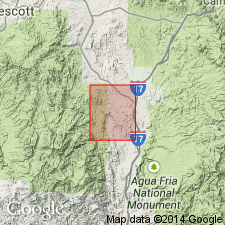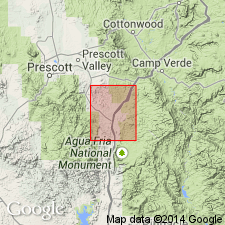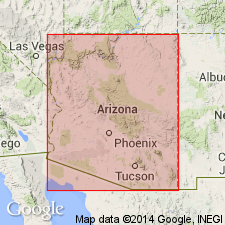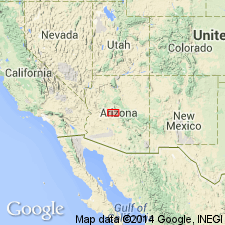
- Usage in publication:
-
- Crazy Basin Quartz Monzonite*
- Modifications:
-
- Named
- Dominant lithology:
-
- Quartz monzonite
- AAPG geologic province:
-
- Basin-and-Range province
Summary:
zzzzzUnit is named the Crazy Basin Quartz Monzonite. Forms part of a large pluton. Consists of coarse-grained quartz monzonite with conspicuous pink microcline crystals. Intrudes the Spud Mountain Volcanics. Age is Precambrian. (B1520) [MENLO GNU]
Source: GNU records (USGS DDS-6; Menlo GNULEX).

- Usage in publication:
-
- Crazy Basin Quartz Monzonite*
- Modifications:
-
- Named
- Dominant lithology:
-
- Quartz monzonite
- AAPG geologic province:
-
- Southwestern Basin-and-Range region
Summary:
zzzzzNamed for exposures in southwest part of quad. Type locality is on Crazy Basin Creek, T10N, R1E, Mayer quad, Yavapai Co, AZ in Southwestern Basin-and-Range region. Exposure in Mayer quad is the northern part of a large pluton that extends southward into Crown King and Bumblebee quads. Intrudes Spud Mountain Volcanics. Is younger than Badger Spring Granodiorite (new). Is a coarse-grained quartz monzonite with conspicuous pink microcline crystals associated with white plagioclase and quartz. Biotite is the chief accessory mineral. Of Precambrian age. [DENVER GNU]
Source: GNU records (USGS DDS-6; Denver GNULEX).

- Usage in publication:
-
- Crazy Basin Quartz Monzonite*
- Modifications:
-
- Age modified
- AAPG geologic province:
-
- Basin-and-Range province
Summary:
Age of the Crazy Basin Quartz Monzonite is Early Proterozoic based on an emplacement age of approximately 1680 Ma.
Source: GNU records (USGS DDS-6; Menlo GNULEX).

- Usage in publication:
-
- Crazy Basin Quartz Monzonite*
- Modifications:
-
- Age modified
- Overview
- AAPG geologic province:
-
- Southwestern Basin-and-Range region
Summary:
Assigned to suite four (of 4) in the Prescott area (Yavapai County, Arizona, Southwestern Basin-and-Range region). Suite four, consisting of syn- to post-tectonic, moderately to coarsely porphyritic, coarse-grained biotite granodiorite to granite plutons, includes the 1,700 +/-5 Ma Crazy Basin Quartz Monzonite, granite of Iron Springs, granodiorite of Yarnell, and granodiorite of Hozoni Ranch. All except Crazy Basin are metaluminous, have moderate to high magnetite concentrations, and high barium, rubidium, zirconium, lanthanum, and cerium. All except Crazy Basin are restricted to the northwestern part of the area. Age of Crazy Basin is refined from Proterozoic X to Early Proterozoic. Report includes geochemical analyses.
Source: Modified from GNU records (USGS DDS-6; Denver GNULEX).
For more information, please contact Nancy Stamm, Geologic Names Committee Secretary.
Asterisk (*) indicates published by U.S. Geological Survey authors.
"No current usage" (†) implies that a name has been abandoned or has fallen into disuse. Former usage and, if known, replacement name given in parentheses ( ).
Slash (/) indicates name conflicts with nomenclatural guidelines (CSN, 1933; ACSN, 1961, 1970; NACSN, 1983, 2005, 2021). May be explained within brackets ([ ]).

